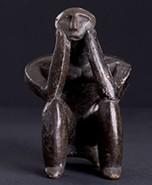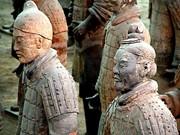Paleolithic

Title: The Venus of Tan-Tan
Location: The artifact is kept at the Museum of Natural History in Austria
Place of origin: Tan-Tan, Morocco
Materials: Quartz rock; ochre paint
A website where you found the picture and the information about the image: visual-arts-cork.com
The period of origin: 200,000-500,000 BCE (“Venus of Tan-Tan,” n.d.)
Physical properties (lines, shapes, colors, textures):
The use of harsh lines and shapes due to the lack of special tools. The track of the ochre paint was found by archaeologists.
Analysis of the formal structure:
Due to the simplicity of the sculpture, it is hard to suppose that there are numerous meanings. All the elements are aimed at depicting the body of an adult woman.
The natural subject: are there any details that have a symbolic meaning? Nowadays, numerous researchers believe that ochre paint was applied to make the artifact special and use it during rituals.
What is the cultural context of the work? What do the images tell you about the culture and the people who created them? Please describe in five to seven sentences.
Almost nothing is known about the cultural context of the discussed work. Nowadays, some researchers still suppose that the Venus of Tan-Tan can be a natural object that just reminds of a woman. Proving this point of view, modern researchers focus on the absence of a face. Despite that, it can be explained by the absence of technology allowing to carve tiny details in stone. The use of ochre paint indicates that the sculpture was used for religious purposes – it is possible that it was used as an ancient protective amulet.
Neolithic

Title: Thinker of Cernavoda
Location: The work is kept at the National Museum of Romania
Place of origin: Cernavoda, Romania
Materials: Terracotta
A website where you found the picture and the information about the image: visual-arts-cork.com
The period of origin: 5000 BCE (“Thinker of Cernavoda,” n.d.)
Physical properties (lines, shapes, colors, textures):
Although the lines are a bit harsh, the creator effectively uses the materials to create a particular mood. All facial features of the person are present, and the face seems to be the focus of the entire sculpture – using tinier tools, the creator manages to depict the emotional state of this person during introspection.
Analysis of the formal structure:
The structure is rather simple as it presents the person who is sitting and reflecting on a certain topic. The majority of researchers are sure that it is a male due to the absence of an exaggerated bust that was typical for the depiction of females. The artist structures and organizes the elements of the sculpture to depict the act of introspection and self-cognition in a detailed way.
The natural subject: are there any details that have a symbolic meaning?
Nowadays, there is no clear opinion explaining the way that such sculptures were used. It seems that there are no details that have a symbolic meaning and can be understood in different ways.
What is the cultural context of the work? What do the images tell you about the culture and the people who created them? Please describe in five to seven sentences.
Considering the lack of decorative elements and symbols, it is unlikely that such sculptures could be used for religious purposes. Instead, the creation of such a work of art can be regarded as one of the earliest attempts to depict emotions with the help of terracotta. Also, it seems that the author was trying to learn more about the best way to depict the human body accurately. In the end, the depiction of the act of introspection can be seen as an attempt to introduce a new theme. Unlike the Thinker, the majority of works of that period were devoted to common activities allowing people to survive.
Iron Age

Title: Chinese Terracotta Army
Location: Xi’an, China
Place of origin: Xi’an, China
Materials: Terracotta
A website where you found the picture and the information about the image: visual-arts-cork.com
The period of origin: 246-208 BCE (“Chinese terracotta army,” n.d.)
Physical properties (lines, shapes, colors, textures): The work presents a collection of sculptures including both people and their horses. The number of shapes used is enormous, but the colors and textures are the same for all pieces. More than that, facial expressions of different sculptures from the army are extremely diverse.
Analysis of the formal structure: The authors who created this collection of sculptures tried to use as many details as it was possible to clearly define the hierarchical position of each warrior. According to different sources, at least seven hundred thousand people took part in its creation.
The natural subject: are there any details that have a symbolic meaning?
In general, every unit of this collection has a symbolic meaning because all warriors and their horses were used to substitute real people that were supposed to be buried together with their emperor.
What is the cultural context of the work? What do the images tell you about the culture and the people who created them? Please describe in five to seven sentences.
When it comes to the cultural context of the work, it is important to mention that its creation took almost forty years. It was an attempt by the first Chinese Emperor to remain powerful even after his death. The entire army was supposed to help the Emperor after his death and let him enjoy the authority. Many people creating the work were also buried in the area. More than that, facial expressions of different sculptures from the army are extremely diverse.
References
Chinese terracotta army. (n.d.). Web.
Thinker of Cernavoda. (n.d.). Web.
Venus of Tan-Tan. (n.d.). Web.